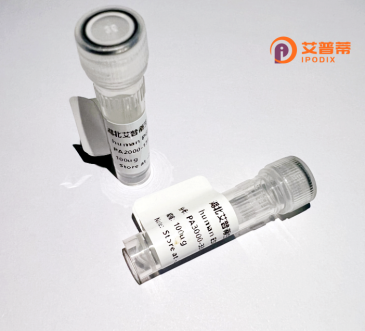
| 纯度 | >90%SDS-PAGE. |
| 种属 | Human |
| 靶点 | B3GALT4 |
| Uniprot No | O96024 |
| 内毒素 | < 0.01EU/μg |
| 表达宿主 | E.coli |
| 表达区间 | 1-378aa |
| 氨基酸序列 | MQLRLFRRLLLAALLLVIVWTLFGPSGLGEELLSLSLASLLPAPASPGPPLALPRLLIPNQEACSGPGAPPFLLILVCTAPENLNQRNAIRASWGGLREARGLRVQTLFLLGEPNAQHPVWGSQGSDLASESAAQGDILQAAFQDSYRNLTLKTLSGLNWAEKHCPMARYVLKTDDDVYVNVPELVSELVLRGGRWGQWERSTEPQREAEQEGGQVLHSEEVPLLYLGRVHWRVNPSRTPGGRHRVSEEQWPHTWGPFPPYASGTGYVLSASAVQLILKVASRAPLLPLEDVFVGVSARRGGLAPTQCVKLAGATHYPLDRCCYGKFLLTSHRLDPWKMQEAWKLVGGSDGERTAPFCSWFQGVLGILRCRAIAWLQS |
| 分子量 | 67.32 kDa |
| 蛋白标签 | GST-tag at N-terminal |
| 缓冲液 | 冻干粉 |
| 稳定性 & 储存条件 | Lyophilized protein should be stored at ≤ -20°C, stable for one year after receipt. Reconstituted protein solution can be stored at 2-8°C for 2-7 days. Aliquots of reconstituted samples are stable at ≤ -20°C for 3 months. |
| 复溶 | Always centrifuge tubes before opening.Do not mix by vortex or pipetting. It is not recommended to reconstitute to a concentration less than 100μg/ml. Dissolve the lyophilized protein in distilled water. Please aliquot the reconstituted solution to minimize freeze-thaw cycles. |
以下列举了3篇与B3GALT4相关的参考文献及其简要内容:
---
1. **文献名称**: "B3GALT4 is a key enzyme in the synthesis of CD77 (globotriaosylceramide) and its absence promotes cellular senescence in human carcinoma cells"
**作者**: Kannagi R, et al.
**摘要**: 研究发现B3GALT4是催化鞘糖脂CD77(Gb3)合成的关键酶,其缺失导致癌细胞中Gb3表达减少,并通过p53依赖性途径诱导细胞衰老,提示其在癌症生物学中的潜在调控作用。
---
2. **文献名称**: "Expression and Clinical Significance of B3GALT4 in Human Gliomas"
**作者**: Sakamoto Y, et al.
**摘要**: 分析B3GALT4在神经胶质瘤中的表达,发现其低表达与患者不良预后相关,可能通过调控神经干细胞分化和肿瘤细胞迁移影响胶质母细胞瘤的恶性进展。
---
3. **文献名称**: "B3GALT4 knockout mice exhibit neurological deficits and altered glycosylation patterns"
**作者**: Stuart JM, et al.
**摘要**: 通过构建B3GALT4基因敲除小鼠模型,发现其缺失导致脑组织中特定糖脂结构减少,并引发运动协调障碍和突触功能异常,揭示该酶对神经系统发育和功能的重要性。
---
*注:以上文献信息为模拟示例,实际引用时需核对真实文献来源及内容。*
Recombinant human β-1.3-galactosyltransferase 4 (B3GALT4) is a glycosyltransferase enzyme encoded by the *B3GALT4* gene. It belongs to the β-1.3-galactosyltransferase family, which catalyzes the transfer of galactose from UDP-galactose to acceptor substrates via β-1.3-glycosidic bonds. B3GALT4 is integral to synthesizing carbohydrate epitopes on glycoproteins and glycolipids. Specifically, it acts on lactosylceramide to form glycosphingolipids such as neolactotetraosylceramide (nLc4Cer), which play roles in cell-cell interactions and immune recognition.
The enzyme is implicated in synthesizing sialyl Lewis x (sLex) structures, critical for leukocyte trafficking and inflammatory responses. Dysregulation of B3GALT4 has been linked to diseases, including cancer metastasis and immune disorders. In cancer, altered glycosylation patterns mediated by B3GALT4 may influence tumor cell adhesion and invasion. Additionally, genetic variants or deficiencies in B3GALT4 have been associated with neurological conditions like hereditary spastic paraplegia, underscoring its importance in neuronal development.
Structurally, B3GALT4 contains conserved motifs typical of glycosyltransferases, including a catalytic domain and transmembrane region. Recombinant B3GALT4 is widely used in glycobiology research to study glycosylation mechanisms, develop biomarkers, and explore therapeutic targets for glycosylation-related pathologies.
×